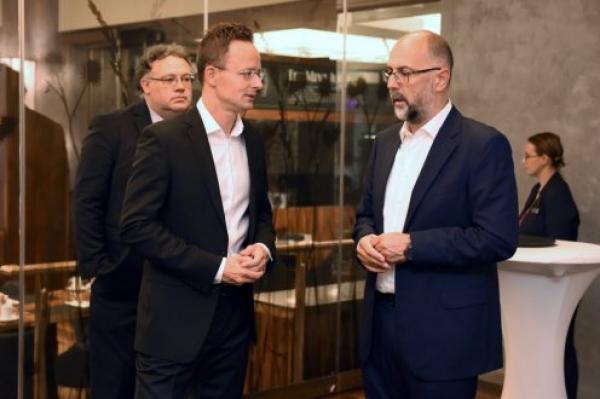Mr. Szijjártó called the trade relations between Hungary and Romania a success story that facilitate favorable developments in relationships between the two countries in other fields.Romania is Hungary’s second most important export market, he added, indicating that Hungarian enterprises exported 4.6 billion euros worth of goods to Romania last year, and exports increased by a further 16 percent according to figures for the first five months of the year. “If things are going well for the Romanian economy and Romania imports a lot that is something from which Hungarian enterprises profit greatly”, the Minister stated. Mr. Szijjártó also pointed out that Hungarian oil company MOL is Romania’s 15th largest enterprise, and OTP Bank is the 14th strongest bank in the country, adding that it was most welcome that the Romanian Government “does not have a negative approach towards OTP’s intentions” to further increase its market share.
The Hungarian Foreign Minister said his invitation to attend the annual meeting of Romanian ambassadors was an indication of mutual trust, adding that a few years ago it would have been difficult to imagine Romania’s Foreign Minister attending the Hungarian ambassadors’ meeting, and Hungary’s Foreign Minister holding a lecture at the Romanian ambassadors’ meeting.
With relation to the opening of the two new border crossing stations, Mr. Szijjártó said the Romanian Government would be giving the Foreign Ministry of Romania a mandate to conduct negotiations, during the course of which it will be rapidly decided which two of the temporary border crossing stations opened in February would remain open permanently. He also told the press that a second motorway border crossing station would also soon open along the Hungarian-Romanian border. By the end of 2019, Hungary’s M4 motorway will reach the border, where border crossing infrastructure will also be constructed, and in the meantime Romania will also make every effort to assure that its M3 motorway also reaches the border.
Mr. Szijjártó also reported on advancements within the field of energy. Natural gas can currently only be transported from Hungary to Romania via the gas interconnector linking the two countries’ natural gas networks. However, Romania has begun work on the development projects that will enable Hungary to purchase 1.75 billion cubic feet of natural gas-a-year from Romania by the end of 2019 and 4.4 billion cubic feet-a-year by the end of 2022. Only a few decisions concerning appropriation are required to also enable the two countries’ electricity networks to become interconnected between Békéscsaba and Nagyvárad (Oradea), he also announced.
With relation to the opening of the Hungarian Cultural Institute in Cluj-Napoca, Mr. Szijjártó said the Romanian Government had also given the Foreign Minister a mandate to negotiate this issue, and talks are expected to close successfully within a few days. Mr. Szijjártó said the “best news of the day” was that his Romanian negotiating partners had reacted positively to Hungary’s plans to launch a Transylvanian economic development programme, after having successfully launched similar initiatives in Vojvodina and Transcarpathia. “The Germans are already working on a similar programme in Romania, and we would like to launch our scheme based on the German model.
The Minister”s visit to Romania had once again begun with a meeting with the President of the RMDSZ, with whom he discussed issues that require solutions in Hungarian-Romanian relations, which he duly raised during later negotiations with Romanian officials. The Minister asked the Romanian officials to help solve the two education-related issues in Târgu Mureș: those involving the Roman Catholic Secondary School and the University of Medicine and Pharmacy. “I believe that with political will and a little goodwill, it will be possible to solve these two issues in the near future”, the Minister declared. We need all possible opportunities to improve mutual respect and build on common success stories. Through improving trust and creating success stories, we can reach a state of affairs in which we can also put in order our outstanding issues”.




